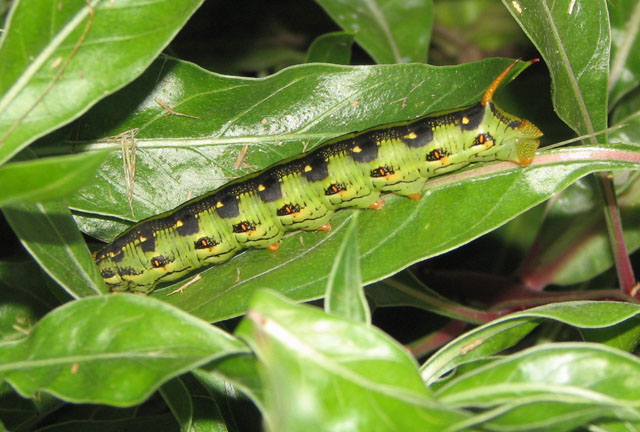Sphinginae subfamily
Sphingini tribe:
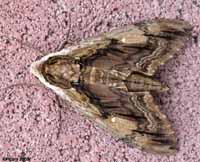 |
Ceratomia amyntor
USGS,
the Elm Sphinx or Four-horned Sphinx
The upperside of the forewing is brown with dark brown and white
markings including a white costal area near the wing base, dark
streaks along the veins, and a white spot in the cell. The upperside
of the hindwing is light brown and has a dark brown band along the
outer margin.
|
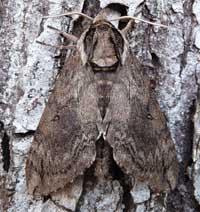 |
The upperside of the forewing is yellowish brown with no white markings, but there are indistinct
black lines and dashes. The cell spot is gray with a black outline and the upperside of the
hindwing is yellowish brown with obscure lines.
Catalpa is the larval host.
|
 |
The upperside of the forewing is pale brownish gray with wavy black
and white lines and a black-outlined white cell spot. The upperside
of the hindwing is gray with diffuse darker bands.
|
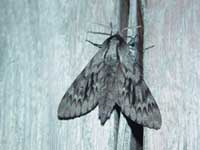 |
The upperside of the forewing is gray with heavy black bands. The
upperside of the hindwing is brownish gray with no markings.
|
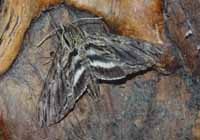 |
The upperside of the forewing is gray-brown with wavy lines, black
dashes, and one or two small
white spots near the center of the costa.
|
 |
Manduca quinquemaculata
USGS the Five-spotted Hawkmoth.
The moth abdomen usually has five but sometimes six pairs of yellow
bands. The upperside of the forewing is blurry brown and gray. The
upperside of the hindwing is banded with brown and white and has two
well-separated median zigzag bands.
|
 |
Manduca sexta WO, the Carolina Sphinx:
The abdomen usually has six pairs of yellow bands, broken across the back. The sixth set of markings is quite small.
The upperside of the forewing has indistinct black, brown, and white markings.
If you grow tomatoes, you have probably encountered it.
Larvae get very large and can strip a tomato plant.
|
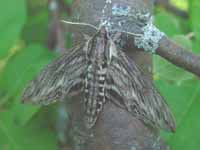
|
Sphinx canadensis
WO,
Sphinx canadensis, the Canadian Sphinx
The absence of the white spot on each forewing and the more brownish coloration serve to separate S. canadensis from
S. poecilus. The hindwing fringe also tends to be white on poecilus and checkered brownish on canadensis.
maybe
|
 |
Sphinx chersis
USGS, the Northern Ash Sphinx or Great Ash
Sphinx:
The upperside of the forewing is soft dark gray to blue-gray with a series of
black dashes, one of which reaches the wing tip. The upperside of the hindwing is black with blurry pale gray bands.
Larval hosts are ash, lilac, privet, cherry, and quaking aspen.
|
 | The costal area is light grey in the basal and median areas. The terminal and marginal areas are also light grey.
The rest of the forewing is dark slatey grey.
|
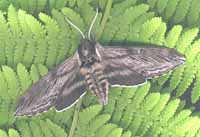 |
If you have blueberries in the woods, then you might have the Poecila
Sphinx. They are pretty common here on Prince Edward Island, but
don't fly too far west of Wisconsin. unlikely
|
 |
The upperside of the forewing has a narrow black subterminal line
bordered by a white inverted V-shaped line on the outside, and a
black line running inwards from the apex of the wing.
It is most often found in montane woodlands and along streamcourses.
|
Smerinthini Tribe:
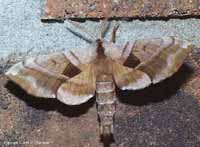 |
The adults are also highly variable; sometimes wings of an individual may be all one color or
may have several colors, ranging from pale to dark brown, and may have a white or pink tinge. Patterns range from faint to pronounced.
|
 |
This moth has a large, heavy body, and females can be remarkably plump.
Lines are diffuse and the forewing has darker and lighter grey to brown areas.
|
 |
Named for the dull grey-blue spot in the hindwing, this moth has a
wide distribution and should be present in Olmsted County.
I regularly see them on Prince Edward Island.
|
 |
Paonias myops
USGS, the Small-eyed Sphinx
Named for the small eye-spot in the hindwing, this moth has a wide
distribution and is confirmed in Olmsted County.
I regularly see them on Prince Edward Island, and they are reported
as far south as Florida.
|
 |
At my home in Montague, P.E.I., Canada, they are quite common.
This is a very easy species to rear.
|
 |
Smerinthus jamaicensis closely resembles Smerinthus cerisyi,
but jamaicensis is much smaller with larger blue patches on
more vibrant and deeper purple in the lower wings.
|
Macroglossinae subfamily
Dilophonotini tribe:
 |
The body is dark brown with a wide white stripe across the abdomen.
The wings are dark brown. The upperside of the hindwing has
pale patches along the costa and inner margin.
rare summer/fall stray
|
 |
The abdomen has very distinct gray and black bands.
Adults nectar at dusk so you may see them in the garen at that time.
probably only as a stray
|
 |
Hemaris thysbe
USGS, the Hummingbird Clearwing
This interesting day flier is confirmed for Olmsted County.
They are widely distributed in the east from P.E.I. to Florida.
|
 |
Hemaris diffinis
USGS, the Snowberry Clearwing or Bumblebee
Moth
This moth is widely distributed and is confirmed
for Olmsted County.
|
Philampelini tribe:
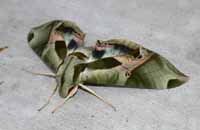 |
Eumorpha pandorus WO, the Pandorus Sphinx:
If you have Grape or Virginia Creeper nearby, then you probably have this species.
I often get asked to identify larvae from areas where they have not previously been reported.
maybe
|
Macroglossini tribe:
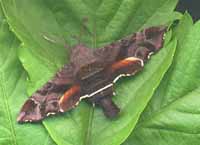 |
This day flier is widely distributed. If you have Virginia Creeper, you
probably have the Nessus Sphinx.
Two bright, distinct, narrow yellow
bands are often visible on the abdomen.
|
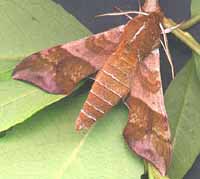 |
They are common in New Jersey and common
here on Prince Edward Island.
You will often see this species listed as Darapsa pholus,
especially in older literature. |
 |
Darapsa myron
USGS, the Virginia Creeper Sphinx or the
Grapevine Sphinx
The forewing upperside is dark brown to pale yellowish gray, with an
olive tint.
On the costal margin there is a dark rectangular patch, although this
may be reduced or absent. The upperside of the hindwing is pale
orange.
|
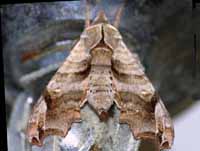 |
The moth's outer margin of the forewing is deeply scalloped.
The upperside is light brown with dark brown markings.
There is a small black and white spot near the tip.
The upperside of the hindwing is orange-brown with a dark brown outer margin and median line.
|
 |
Hyles gallii WO, the Bedstraw Hawk Moth
or Gallium Sphinx
This species is not reported in Minnesota by USGS, but I expect it is present.
Some years I see them on P.E.I., some years, I do not.
|
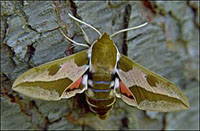 |
Hyles euphorbiae
WO, the Spurge Hawk Moth
The body is light brown with various white and dark brown
markings, while the wings have a conspicuous tan, brown, and pink or
red color pattern.
maybe
|
 |
Hyles lineata
CC/USGS,
the White-lined Sphinx
The forewing upperside is dark olive brown with paler brown along the
costa and outer margin, a narrow tan band running from the wing tip
to the base, and white streaks along the veins. |
Hyles lineata larvae, August 21, 2006, courtesy of Cristine Charlesworth.
|
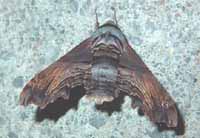 |
This moth is very much under reported. It is a
rapid day flier so is probably not in too many collections. Grape is a popular larval host.
|
|
